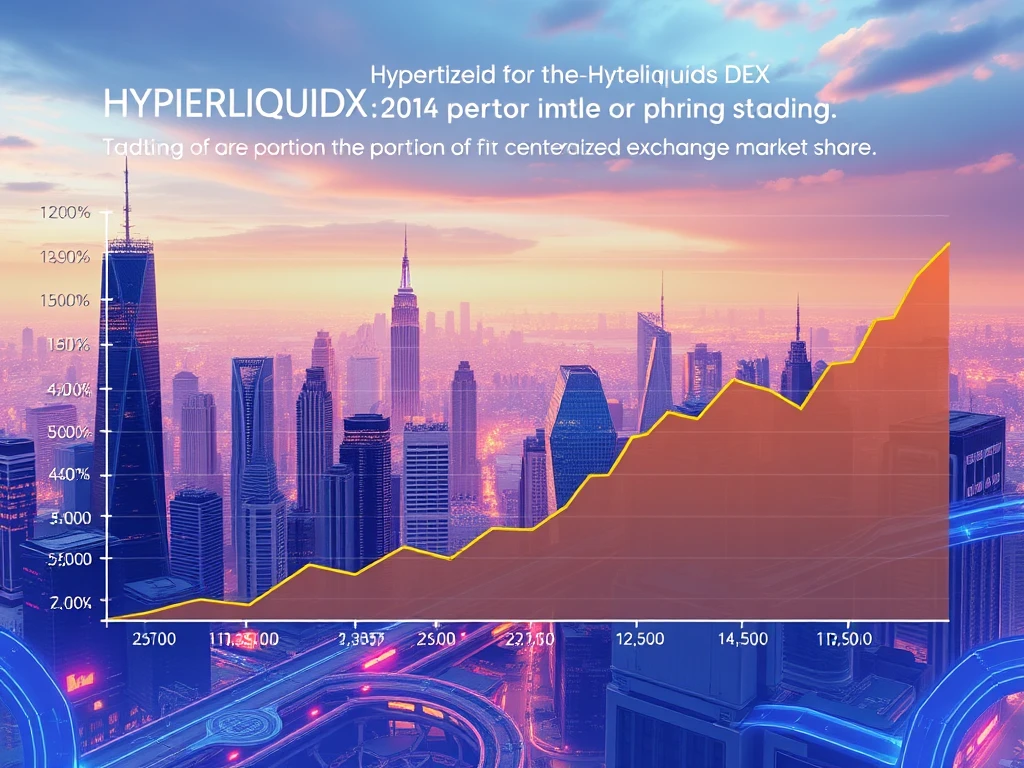Explosive Growth: Hyperliquid DEX Trading Volume Eclipses CEX Market Share

Is the reign of centralized exchanges (CEXs) facing a formidable challenger? Recent data reveals a fascinating shift in the cryptocurrency trading landscape. Hyperliquid, a decentralized exchange (DEX), is experiencing explosive growth in trading volume, directly impacting the market share traditionally held by CEX giants. Let’s dive into the numbers and explore what’s fueling this paradigm shift in crypto trading volume.
Hyperliquid DEX: Surging in DEX Trading Volume
Hyperliquid has emerged as a standout success story in the decentralized finance (DeFi) space. Launched in 2023, this DEX has rapidly climbed the ranks to become the leading decentralized derivatives platform. Impressively, Hyperliquid now commands nearly 60% of the DEX derivatives market, boasting daily trading volumes that have peaked at a staggering $4 billion. While still trailing behind the colossal $50 billion daily average volume of Binance Futures, the trend is undeniable: Hyperliquid is aggressively encroaching on centralized exchange territory. This surge in DEX trading volume signals a significant evolution in how traders are interacting with the crypto market.
What’s Driving Hyperliquid’s Ascent in Crypto Trading Volume?
Several factors contribute to Hyperliquid’s parabolic rise in crypto trading volume:
- Strategic Spot Trading Launch: The introduction of spot trading in April 2024 proved to be a pivotal moment, attracting a wave of new users to the platform.
- Aggressive Token Listing Strategy: Hyperliquid’s proactive approach to listing new and trending tokens has kept its platform vibrant and appealing to traders seeking diverse opportunities.
- User-Friendly Onchain Interface: Ease of use is paramount in DeFi. Hyperliquid’s intuitive onchain user interface lowers the barrier to entry, making it accessible to a broader range of users.
- HYPE Token Launch Catalyst: The November 2024 launch of the HYPE token acted as a major catalyst. It ignited trading activity and significantly boosted Hyperliquid’s overall crypto trading volume.
Data from Dune Analytics underscores this impressive growth. Hyperliquid now boasts over 400,000 users and has processed more than 50 billion trades. The platform’s cumulative trades and user growth are a testament to its increasing popularity within the crypto community.
Hyperliquid’s Expansion Beyond a DEX: Building a Layer-1 Ecosystem
Hyperliquid’s ambitions extend beyond being just a high-performance perpetual futures and spot DEX. With the launch of HyperEVM in February 2025, the project has transitioned into a general-purpose layer-1 blockchain. This strategic move allows for the development of third-party DeFi applications on top of its robust infrastructure. Jeff Yan, a Hyperliquid founder, articulated this vision, stating that they are focusing on “polish[ing] a native application and then grow[ing] into general-purpose infrastructure,” contrasting with the approach of L1s that build infrastructure hoping for killer apps to emerge.
This approach could create a powerful flywheel effect. The liquidity generated by Hyperliquid’s core DEX can naturally flow into the broader ecosystem and vice versa, fostering synergistic growth and expanding the reach of DeFi.
Challenging CEX Market Share: A New Era for DEXs?
According to CoinGecko, Hyperliquid now ranks 14th among derivatives exchanges by open interest, currently at $3.1 billion. While still behind Binance’s $22 billion, it surpasses established CEX derivatives divisions like Deribit, Crypto.com, BitMEX, and KuCoin. This marks a significant milestone: it’s the first time a DEX is competing so closely with traditional centralized exchanges for CEX market share.
Hyperliquid’s focus on specialized trading pairs further intensifies its challenge to the CEX market share dominance. By accepting not only Arbitrum USDC but also native BTC as collateral, Hyperliquid distinguishes itself. It’s among the few decentralized platforms offering native BTC wrapping and unwrapping, empowering users to trade directly with BTC through their Web3 wallets. Crypto analyst Skewga.hl highlighted that Hyperliquid’s BTC perpetual futures volume share recently reached an all-time high, approaching 50% of Bybit’s and 21% of Binance’s. Skewga.hl aptly noted, “No DEX has ever come this close to matching Tier 1 CEX volume.”
The resurgence of perpetual swaps as a preferred trading tool since 2024 further benefits Hyperliquid. Daily perps volume, which averaged around $5 billion during the 2021-2022 bull market, has often exceeded $15 billion in early 2025, with Hyperliquid capturing nearly two-thirds of this volume. DefiLlama data visually demonstrates this shift, showing Hyperliquid taking the lead in perps volume, surpassing previous leaders like dYdX.
The Road Ahead for Hyperliquid and DEXs
Despite a recent controversy involving the JELLY token, Hyperliquid maintains its popularity among DeFi and DEX traders. While it has yet to fully attract institutional investors or reach the sheer scale of top-tier CEXs, Hyperliquid’s trajectory is compelling. If its layer-1 ecosystem gains momentum and attracts developers, Hyperliquid has the potential to evolve into much more than just a leading DEX. It could become a cornerstone of a new decentralized financial infrastructure, further impacting the CEX market share landscape.
In Conclusion:
- Hyperliquid’s DEX trading volume is experiencing explosive growth, challenging the established dominance of CEXs.
- Strategic initiatives, a user-friendly platform, and the HYPE token launch are key drivers behind Hyperliquid’s success.
- Hyperliquid’s expansion into a layer-1 blockchain could further solidify its position in the DeFi ecosystem.
- The rise of Hyperliquid signals a potential paradigm shift in crypto trading, with DEXs increasingly competing for CEX market share.
It’s crucial to remember that the crypto market is dynamic and investments carry risk. Always conduct thorough research before making any trading decisions. The evolution of platforms like Hyperliquid highlights the exciting and ever-changing nature of the cryptocurrency space.








